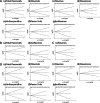Consumption of flavonoids and risk of hormone-related cancers: a systematic review and meta-analysis of observational studies
- PMID: 35545772
- PMCID: PMC9092883
- DOI: 10.1186/s12937-022-00778-w
Consumption of flavonoids and risk of hormone-related cancers: a systematic review and meta-analysis of observational studies
Abstract
Background: Flavonoids seem to have hormone-like and anti-hormone properties so that the consumption of flavonoids may have potential effects on hormone-related cancers (HRCs), but the findings have been inconsistent so far. This meta-analysis was aimed to explore the association between flavonoids intake and HRCs risk among observational studies.
Methods: Qualified articles, published on PubMed, EMBASE, and China National Knowledge Infrastructure (CNKI) from January 1999 to March 2022 and focused on relationships between flavonoids (total, subclass of and individual flavonoids) and HRCs (breast, ovarian, endometrial, thyroid, prostate and testicular cancer), were retrieved for pooled analysis. Random effects models were performed to calculate the pooled odds ratios (ORs) and corresponding 95% confidence intervals (CIs). Funnel plots and Begg's/Egger's test were used to evaluate the publication bias. Subgroup analyses and sensitivity analyses were conducted to explore the origins of heterogeneity.
Results: All included studies were rated as medium or high quality. Higher consumption of flavonols (OR = 0.85, 95% CI: 0.76-0.94), flavones (OR = 0.85, 95% CI: 0.77-0.95) and isoflavones (OR = 0.87, 95% CI: 0.82-0.92) was associated with a decreased risk of women-specific cancers (breast, ovarian and endometrial cancer), while the higher intake of total flavonoids was linked to a significantly elevated risk of prostate cancer (OR = 1.11, 95% CI: 1.02-1.21). A little evidence implied that thyroid cancer risk was augmented with the higher intake of flavones (OR = 1.24, 95% CI: 1.03-1.50) and flavanones (OR = 1.31, 95% CI: 1.09-1.57).
Conclusions: The present study suggests evidence that intake of total flavonoids, flavonols, flavones, flavanones, flavan-3-ols and isoflavones would be associated with a lower or higher risk of HRCs, which perhaps provides guidance for diet guidelines to a certain extent.
Trial registration: This protocol has been registered on PROSPERO with registration number CRD42020200720 .
Keywords: Flavonoid subclasses; Flavonoids; Hormone-related cancers; Meta-analysis; Observational studies.
© 2022. The Author(s).
Conflict of interest statement
The authors declare no potential competing interests.
Figures





Similar articles
-
Flavonoids, flavonoid subclasses and breast cancer risk: a meta-analysis of epidemiologic studies.PLoS One. 2013;8(1):e54318. doi: 10.1371/journal.pone.0054318. Epub 2013 Jan 18. PLoS One. 2013. PMID: 23349849 Free PMC article.
-
Association between dietary flavonoid intake and depressive symptoms: A cross-sectional research.Gen Hosp Psychiatry. 2024 Jan-Feb;86:75-84. doi: 10.1016/j.genhosppsych.2023.12.005. Epub 2023 Dec 15. Gen Hosp Psychiatry. 2024. PMID: 38134552
-
Habitual intake of flavonoid subclasses and risk of colorectal cancer in 2 large prospective cohorts.Am J Clin Nutr. 2016 Jan;103(1):184-91. doi: 10.3945/ajcn.115.117507. Epub 2015 Nov 4. Am J Clin Nutr. 2016. PMID: 26537935 Free PMC article.
-
Flavonoid subclasses and type 2 diabetes mellitus risk: a meta-analysis of prospective cohort studies.Crit Rev Food Sci Nutr. 2019;59(17):2850-2862. doi: 10.1080/10408398.2018.1476964. Epub 2019 Jan 21. Crit Rev Food Sci Nutr. 2019. PMID: 29768032 Review.
-
Dietary Flavonoids and the Risk of Colorectal Cancer: An Updated Meta-Analysis of Epidemiological Studies.Nutrients. 2018 Jul 23;10(7):950. doi: 10.3390/nu10070950. Nutrients. 2018. PMID: 30041489 Free PMC article. Review.
Cited by
-
Association between dietary intake of flavonoid and chronic kidney disease in US adults: Evidence from NHANES 2007-2008, 2009-2010, and 2017-2018.PLoS One. 2024 Aug 27;19(8):e0309026. doi: 10.1371/journal.pone.0309026. eCollection 2024. PLoS One. 2024. PMID: 39190642 Free PMC article.
-
Phenolic Acids-Mediated Regulation of Molecular Targets in Ovarian Cancer: Current Understanding and Future Perspectives.Pharmaceuticals (Basel). 2023 Feb 11;16(2):274. doi: 10.3390/ph16020274. Pharmaceuticals (Basel). 2023. PMID: 37259418 Free PMC article. Review.
-
Puerarin inhibits EMT induced by oxaliplatin via targeting carbonic anhydrase XII.Front Pharmacol. 2022 Aug 25;13:969422. doi: 10.3389/fphar.2022.969422. eCollection 2022. Front Pharmacol. 2022. PMID: 36091779 Free PMC article.
-
Intake of the Total, Classes, and Subclasses of (Poly)Phenols and Risk of Prostate Cancer: A Prospective Analysis of the EPIC Study.Cancers (Basel). 2023 Aug 11;15(16):4067. doi: 10.3390/cancers15164067. Cancers (Basel). 2023. PMID: 37627095 Free PMC article.
-
Association of dietary flavonoid intakes with prevalence of chronic respiratory diseases in adults.J Transl Med. 2024 Feb 26;22(1):205. doi: 10.1186/s12967-024-04949-7. J Transl Med. 2024. PMID: 38409037 Free PMC article.
References
Publication types
MeSH terms
Substances
LinkOut - more resources
Full Text Sources
Medical

